
Plague Quarantine Page Menu: 1 2 3 4 5 6 7 8 9 10 11 12 13 14 15 Next>>
Golden Age of Piracy Maritime Quarantine For Plague, Page 7
Quarantine at the Mediterranean Lazarettos: People (Continued)
The Lazaretto Quarantine Experience - Rooms
Once the preliminary procedures had been completed, patients were mostly left to their own devices. Both Jean-Jacques Rousseau (1741 at Genoa) and John Howard (1786 at Venice)
Photo: Wiki User Powermelon
The Two Stories of the Lazaretto Vecchio in Venice
talk about how sparse the lazaretto rooms were. Rousseau says he was "conducted to a large building of two stories, quite empty, in which I found neither window, bed, table, nor chair, not so much as even a joint stool or bundle of straw."1 The sparseness of the furnishings should not be surprising. No one was entirely sure how the plague virus was transmitted but natural products such as wood, cloth and leather were suspected of carrying it. When people died of the plague, those of their belongings made of such materials were supposed to be burned rather than risk their transmitting the plague.
Despite the purpose of the structure, lazarettos do not appear to have been very clean. Howard explains that he was shown "a very dirty room, full of vermin, and without table, chair, or bed."2 As a result, Howard decided to hire "a person to wash my room: but this did not remove the offensiveness of it"3.
He was so disenchanted with his quarters at Lazaretto Nu ovo that he made an effort to be moved to the other Venetian lazaretto. He explains that with a report from his guardian about his healthiness and, "on the representation of our consul, I was conducted to the old lazaretto [Lazaretto Vecchio] which is nearer the city. Having brought a letter to the prior from the Venetian ambassador at Constantinople, I hoped now to have had a comfortable lodging."4 Such was not the case, however. "The [new] apartment appointed me (consisting of an upper and a lower room) was no less disagreeable and offensive than the former. I preferred lying in the lower room on a brick floor where I was almost surrounded with water."5
Howard was again moved six days later, this time to an 'apartment' with four rooms with a nice view. He reported that the new habitation was again "without furniture, very dirty, and no less offensive than the sick wards of the worst hospital. The Walls of my chamber, not having been cleaned probably for half a century, were saturated with infection."6 He once again attempted to clean the rooms, this time with boiling water, but this also proved to be unsatisfactory. He then washed the walls with a water/lime mixture, thanks to the British consul, "who was so good as to supply me with a quarter of a bushel of fresh lime for the purpose. And the consequence was, that my room was immediately rendered so sweet and fresh, that I was able to drink tea in it in the afternoon, and to lie in it the following night."7
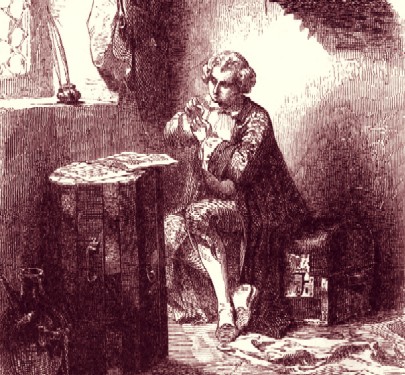
Artist: Henri Baron - Rousseau Depicted in His Room in Messina (1836)
Rousseau does not mention being troubled by the cleanliness his rooms at the Genoa lazaretto, although he says he did bring some unwanted pestilence with him. Once he settled into his quarters, "I had the amusement of destroying the vermin [lice] I had caught in the Felucca [narrow sailing vessel]."8 He then changed his clothing and set about making his quarters more habitable.
I made a good matrass with my waistcoats and shirts; my napkins I converted, by sewing them together, into sheets; my robe de chambre, into a counterpane; and my cloak, into a pillow. I made myself a seat with one of my trunks laid flat, and a table with the other. I took out some writing paper and an ink stand, and distributed, in the manner of a library, a dozen books which I had with me. In a word, I so well arranged my few moveables, that, except curtains and windows, I was almost as commodiously lodged in this Lazaretto, absolutely empty as it was, as I had been at the Tennis Court in the Rue Verdelet.9
The Maltese lazaretto had second-story quarters, although it was not even as well regarded as the Venice lazaretto. Historian Paul Cassar says the
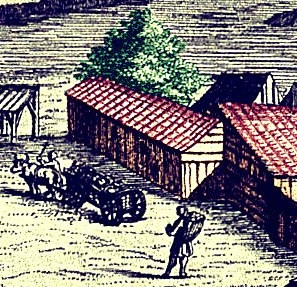
The quarantine house, From Das Regenspurgische
Lazareth mit seiner gantzen Gegend (1714)
rooms used at Manoel Island contained several small rooms on the second floor of the building.10 Howard mentions these as well, noting that they lacked good ventilation. He explains, "Additions have been made to it at different times. The old part is inconvenient, and too close [lacking airflow] to admit of a proper ventilation of cottons and other merchandise. It has sixteen rooms on two floors. On the higher floor there are eight, which open into a balcony, and have opposite windows: but all were very dirty."11
Writing about the Marseille lazaretto in 1836, Armand Pignel noted that "Each apartment consists of a large square room with fireplace"12. Of this lazaretto, Howard says, "Among other apartments for passengers, there are twenty-four large rooms, of which some are above stairs, and open into a spacious gallery enclosed by lattice. In these rooms are closets for beds, which the passengers and guards are required to bring with them."13 Howard's mention of these rooms being larger than others suggest that he is talking about special quarters which are marked on the diagram he includes of the structure in his book as being reserved for 'distinguished' passengers. (See the section on the Marseille Lazarettos later in this article for a reproduction of his diagram.)
1 Jean Jacques Rousseau, The Confessions of Jean Jacques Rousseau, Citizen of Geneva, Part the Second, Volume 1, 1790, p. 44; 2, 3, 4, 5, 6, 7 John Howard, An Account of the Principal Lazarettos In Europe, 1791, p. 11; 8,9 Rousseau, p. 44; 10 Paul Cassar, A Tour of the Lazzaretto Buildings (Malta), 2004, p. 373; 11 Howard, p. 18; 12 Armand Pignel, Conducteur ou guide du voyageur et du colon de Paris a Alger et dans L’Algerie, Avec Carte Itineraire, 1836, p. 219, translated by the author; 13 Howard, p. 4
The Lazaretto Quarantine Experience - Food & Supplies
The 1695 rules for the Messina lazaretto state that the lazaretto opened a tavern 'during quarantine time' which sold "wine, and every kind of edible, so that such commodities can be provided to the people serving quarantine, if they want it"1. The rules don't say much else about the food which was offered there, but they do talk a lot
about how food arrived and was be served. The tavern was not to interfere in anyway with the quarantine procedures nor was it to allow people serving different quarantines to interact
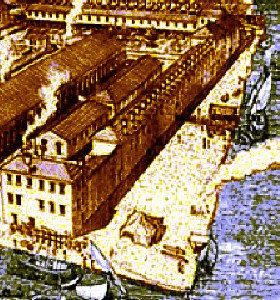
Artist: Antonio Visentini
Entry Gate Isola del Lazaretto Nuovo, Venice (1738)
with one another. Food was served through a small window. The tavern's cooking fire had to be coal-fueled, because wood was thought to carry infection, and was only to be lit during the day.
Vendors from the city were also allowed to offer food for sale to people serving quarantine at the Venice lazarettos, provided the vendor had a license to do so. This food could only be offered at the main door of the lazaretto with the vendors keeping a distance of 'twenty canes [or possibly rods]' from the people serving quarantine. Anything purchased by those in quarantine was delivered to them by the custodian of the lazaretto. Custodians also carried payment back to the vendors, but only after soaking it in vinegar or sea water to remove any possible taint.2
John Howard mentions this is how food and supplies were purchased in the Venice lazaretto, with two vendors arriving each morning in a boat at the lazaretto entry gate with supplies. His description follows that given in the Messina instructions, with a few minor differences. Only certain vendors were appointed to provide food and supplies. They came to the lazaretto every day, bringing the things that those in quarantine ordered. The vendors were not to enter the lazaretto, "but have a convenient place assigned them, where the guardians and passengers can come to see their provisions, and to give their orders"3 Orders were delivered using "baskets fastened to poles of seven or eight feet long, in which they reach every thing to those within, and in presence of the prior or his substitute, who cause the money to be dipped in vinegar or salt water, before the sutlers take it."4
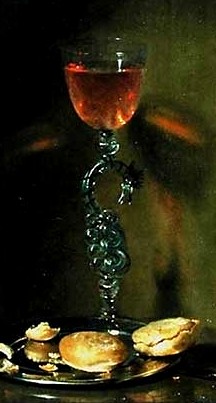
Artist: Isaac Luttichuys
Still Life with Bread and Wine
(Definitely a bit fancier than what was
provided in the lazaretto.)
(17th century)
The Messina rules also state that individuals from the city could provide food to people they knew who were in quarantine, "both those in Lazaretto and those on the boats, but the food must be given to the Custodian, who is obliged to make sure it is given to the person, or persons, to whom it is intended"5. This food had to be provided freely to the recipients or the seller would need a license to vend at the lazaretto as stated earlier.
Economist and historian Carlo Cipolla provides a list of the foods that were available in the small, land-based 'pest-house' [lazaretto] in Prato, Italy in 1630. Cipolla's list includes bread, wine, meat, dry grapes (raisins), vinegar (for cleaning), eggs, oil, salt, chickens, beans and nuts. However, he also explains that, based on the quantities consumed of each of these things, "It is evident that the diet in the pest-house consisted essentially of bread, meat and wine."6 Howard gives a list of some of the supplies when discussing the cost of goods. "The price of bread, butter, milk, fruit, and fuel, which I purchased, was about one third more than the price in the city."7 His list compares fairly well with Cipolla's list written a century and a half earlier.
Instructions issued by the Serenissima Republic in 1661 for Corsica, Caprara Island and Genoa say that provisions brought within their jurisdiction which were damaged by sea water or had otherwise deteriorated were to be seized by health officials in an effort to verify the "quality of grains, beans and legumes; as well as fetid salami and for every other edible thing, which could bring harm to health."8
Frenchman Jean-Jacques Rousseau doesn't talk about the food provided at Messina, but he does give some detail about the process of eating it. Tongue firmly in cheek, he explains that "dinners were served
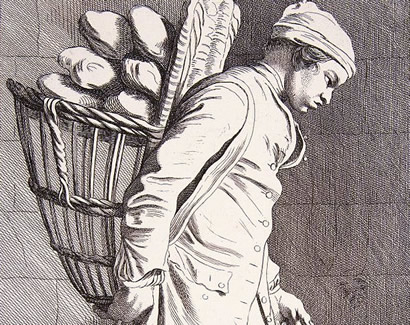
Artist: Anne Claude de Caylus -
Baker's Boy Delivering Bread (1746)
with no small degree of pomp; they were escorted by two grenadiers with bayonets fixed; the stair-case [in his quarters] was my dining room, the landing place my table, and the step served me for a seat; and as soon as my dinner was served up a little bell was rung to inform me I might sit down to table."9
For food at Marseille's Lazaret d' Arenc, Howard explains that a guard is assigned to a group of passengers (which is not to exceed three) to whom they paid 20 sous a day. "These guards perform the offices of servants; and will cook for passengers, if they do not choose to have their victuals from the tavern."20 Of the tavern, Howard says "Persons under quarantine may have their dinners and suppers sent them [there], and which has likewise the exclusive privilege of supplying them with wine."10 Armand Pignell mentions the guards without suggesting that they serve or cook for those serving quarantine in his 1836 travel guide. However, he does say, "The tavern at the lazaretto of Marseille is very good."11 However, since this reference is to an experience so long after the end of the golden age of piracy, it is impossible to say if this were also true during the period of interest.
1 Instruzzioni e gouerno del lazzaretto di Messina per la scala franca, 1695, p. 20 - translated by the author; 2 Instruzzioni e gouerno del lazzaretto di Messina..., p. 21; 3,4 John Howard, An Account of the Principal Lazarettos In Europe, 1791, p. 15; 5 Instruzzioni e gouerno del lazzaretto di Messina..., p. 21; 6 Carlo M Cipolla, Cristofano and the Plague, 1973, p. 149; 7 Howard, p. 15; 8 Simona Olivieri, "Istruzione ed ordini per la Sanità da osservarsi in tutti quei luoghi che hanno giurisdizione al mare, nell'una e l'altra Riviera della Serenissima Repubblica, compreso il Regno di Corsica, ed isola di Caprara", La Berio, Jan-Jul, 1999, p. 28; 9 Jean Jacques Rousseau, The Confessions of Jean Jacques Rousseau, Citizen of Geneva, Part the Second, Volume 1, 1790, p. 44; 10 Howard, p. 4; 11 Armand Pignel, Conducteur ou guide du voyageur et du colon de Paris a Alger et dans L’Algerie, Avec Carte Itineraire, 1836, p. 219, translated by the author
The Lazaretto Quarantine Experience - Personal Possessions
Passengers serving quarantine in the lazaretto were typically allowed to keep their personal possessions other than weapons and those things subject to quarantine. The 1695 Messina
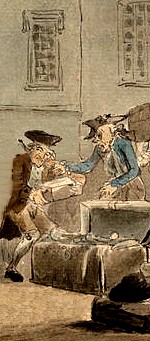
Artist: Thomas Rowlandson
Unpacking a Trunk (1790s)
Lazaretto rules say that passengers' suitcases and other goods were to be "put away with the other merchandise subject to quarantine to carry out the usual purge, leaving the Passengers with the usual things they need for for every day use, the rest being subject to purge."1
In practice, at least in the two post-GAoP accounts, most of the passengers' items not subject to purge seem to have been returned to them. Frenchman Jean-Jacques Rousseau says that after he had chosen his domicile in the lazaretto, the guardians "brought me my cloak, my travelling bag, and my two trunks"2. He doesn't go into more detail there, but it is notable that nothing is mentioned as being removed from his bags and his clothing was returned, something that normally would have been liable to goods quarantine. In the Rousseau quote cited in the previous section detailing how he set up his room, Rousseau mentioned having his waistcoats, shirts, napkins robe, cloak, writing paper, books and an ink stand. Had they been classified as 'goods', all of these things except the ink stand would have been subject to quarantine.
John Howard says the lazaretto guardians were to "cause the passengers to expose their apparel, and other effects to the open air every day, and that they give all proper assistance to those under their guard."3 Again, no mention is made of anything being removed in his account, although the passengers were required to perform their own airing of suspect goods. This may have applied to Rousseau as well, although he doesn't say as much.
The 1695 Messina rules emphatically state that the Custodian must "collect any kind of weapons of the people, which will be admitted to the Lazzaretto"4, first removing their 'covers'. This almost certainly refers to leather or cardboard sheaths on bladed weapons as well as whatever cloth or leather cover might be used on guns. (Leather, paper and fabric were subject to quarantine.) However, the collected weapons were to be kept in good, working condition by the lazaretto personnel and any defects in the weapons were to be noted when it was received so that the owner couldn't complain about its being damaged while under the lazaretto's care. John Howard likewise explains that the prior at the Venetian lazaretto was "to take into his possession all sorts of arms belonging to passengers, which are to be restored when the quarantine is finished."5 This rule is not mentioned as being applied to the people serving quarantine on their ships.
1 Instruzzioni e gouerno del lazzaretto di Messina per la scala franca, 1695, p. 17 - translated by the author; 2 Jean Jacques Rousseau, The Confessions of Jean Jacques Rousseau, Citizen of Geneva, Part the Second, Volume 1, 1790, p. 44; 2 John Howard, An Account of the Principal Lazarettos In Europe, 1791, p. 15; 3 Instruzzioni e gouerno del lazzaretto di Messina... p. 17
The Lazaretto Quarantine Experience - Visitors and Communication
Visitors were not allowed inside the lazaretto proper. The 1695 Messina lazaretto rules even specified that "[t]he Guardians and Porters will not allow their Wives, Sons, or any other person in their company" when going into the lazaretto.1 This doesn't mean that no one was allowed to talk with those serving quarantine in the lazaretto, however. The Messina rules mention that visitors are allowed to see those in quarantine, but only if they kept "a channel of water between them", not allowing even scents to pass between them (because of the fear of contagion in the air).2 In addition, such meetings were to be constantly monitored by the guardian in charge of the individual in the lazaretto. John Howard mentions that people visiting were required to have a mandate or order permitting them to visit the patient.
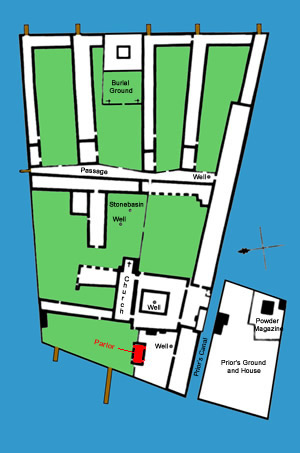
Parlor Location (Indicated in Red) on Lazaretto Vecchio. Note
the Prior's Canal Between the Lazaretto and the Prior's
Island. From John Howard's An Account of the Principal
Lazarettos In Europe (1789)
Howard also details other methods used to keep people under quarantine from getting too close to their visitors. About the Venice lazaretto, he says, "Adjoining to the prior's house, there are parloirs, where these visits are made generally in the presence of the prior, sub-prior or guardian, and sometimes of all of them."3 In the diagram of Lazaretto Vecchio, where Howard spent most of his quarantine, the parlor is shown at right in red. While not exactly 'adjoining' the prior's house, there is a canal between the his house and the lazaretto which agrees in some ways with the Messina rules. So it's possible the parlor shown in the lazaretto plan is different from that used by visitors. In another explanation of separating visitors from those in quarantine in Venice from 1765, Samuel Sharp explained that "visitors are not suffered to approach the person of any who is performing quarantine. They are divided by a passage of about seven or eight feet wide."4 No mention of water appears here.
Howard also describes the method used for visitors to the lazaretto at Marseille, France, which also used parlors. He explains that these
are long galleries with seats in them, situated between the gates, and separated by wooden balustrades and wire lattice, beyond which there are other balustrades, distant about ten feet, at which the persons in quarantine may see and converse with such friends as may choose to visit them. The wires are intended to prevent any thing from being handed to them, or from them. And that nothing may be thrown over, and no escapes be made, there is a double wall round the lazaretto.5
Writing of the same lazaretto in Marseille (Lazaretto d'Arenc) in 1836, travel guide writer Armand Pignel says that the two galleries are separated "by a double wooden grid, in the middle of the two grids is a wire frame to prevent anything from passing out of the lazaretto. The distance from one grid to another is about 6 feet."6 Since his description is almost fifty years after Howard's, it is possible this was modified.
Howard also states that people are called to the Marseille parlor when they have a visitor using a bell
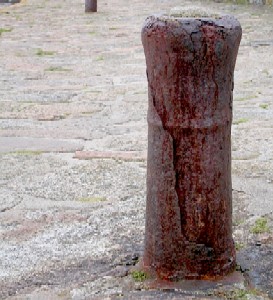
Artist: Bob Embleton
Apropos of Nothing, Cannons Were Often Used as
Bollards,
From the West Pier of St. Michaels Mount Harbour
located at the gate of the lazaretto. He explains that "by the number and other modifications of the [bell-]strokes, every individual knows when he is called."7 Pignel similarly notes "there is a bell which the concierge sounds a number of strokes agreed to bring to the parlor those in quarantine who are waiting for visits."8
At the Malta lazaretto on Manoel Island, Howard says that for interaction between those inside the lazaretto and vendors or visitors, "there are enclosures separated by stone posts, with rails and palisades: and two soldiers stationed to prevent any improper communication."9
Several modern historians describe the Maltese system for allowing those serving quarantine to receive visitors. Paul Cassar says "The ground floor of the Health Office was a speaking-place or parlatorio where, under proper restrictions, conversation was permitted between the inhabitants on one side of a barrier and the passengers and crews in quarantine on the other side, in such a way that they could not touch one another."10 Charles Savona-Ventura adds, “The building was surrounded by a series of bollards holding an array of ropes to provide a barrier between the inmates and any visitors. This feature gave rise to the name by which the site is known to this day, the Barriera. Orderlies were allocated to this unit. …The Barriera was mainly intended for passengers who were free from disease, but who were obliged to undergo a period of quarantine."11
Cassar also mentions how visitors communicated at one of the other Maltese lazarettos at Valletta. He explains that the wharf there was called "known as il barriera from the Italian word meaning a 'barrier', the allusion being to an arrangement of railings which allowed persons undergoing quarantine to talk to the inhabitants but prevented them from coming in close physical contact with the latter."12
1 Instruzzioni e gouerno del lazzaretto di Messina per la scala franca, 1695, p. 15; 2 Instruzzioni e gouerno del lazzaretto di Messina..., p. 15; 3 John Howard, An Account of the Principal Lazarettos In Europe, 1791, p. 14; 4 Samuel Sharp, Letters from Italy, 1766, p. 10; 5 Howard, p. 4; 6 Armand Pignel, Conducteur ou guide du voyageur et du colon de Paris a Alger et dans L’Algerie, Avec Carte Itineraire, 1836, p. 221, translated by the author; 7 Howard, p. 4; 8 Pignel, p. 221; 9 Howard, p. 8; 10 Paul Cassar, A Tour of the Lazzaretto Buildings (Malta), 2004, p. 377; 11 Charles Savona-Ventura, Knight Hospitaller Medicine in Malta [1530-1789], 2015, p. 48; 12 Cassar, p. 369
The Lazaretto Quarantine Experience - The Sick and the Dead
Anyone becoming ill in the lazaretto was to be dealt with quickly and carefully.
From his experience in the Venice lazarettos, John Howard explains that when either a passenger under quarantine or a porter assigned to the lazaretto became sick, the guardian assigned to them 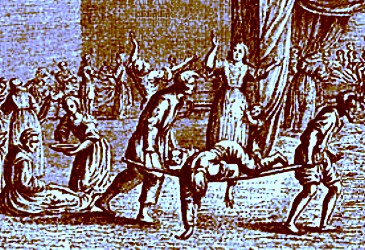
Artist: Christian Friedrich Fritzsch
Treating the Ill in a Lazaretto, From Plague Hospital in Hamburg (1758)
made sure that the person "is separated from others in the same apartment as much as possible, and immediately gives notice to the board, who send their Physician to diligently examine the nature of the disease, and another Physician may be called to assist him"1. It is not clear from this description how the physicians did this because if they got too close to the people under quarantine, they would be required to serve the rest of the quarantine with them.
The 1695 Messina instructions agree with Howard's explanation, with a few small differences. They indicate that when someone falls ill, the guardian is to give a written account of what happened to the patient to the Deputy of Health. The Deputy then sends doctors to observe that patients and to make sure that such patients "do not remain without the necessary remedies & medical assistance. If these doctors came into close contact with the patients in the lazaretto, they were then obliged to remain in quarantine at the expense of the sick, whom they assist."2 This was likely also true when Howard served his quarantine at Venice, which explains how the physicians could visit those who became sick in the lazaretto.
The instructions governing the Marseille lazaretto in 1716 state that anyone showed signs of the plague while in quarantine at the
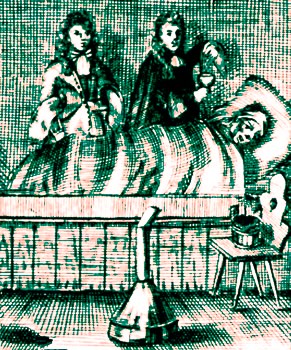
Man In Bed By Fumigation Stove, From Die Belagert
u Entente Venus, By Stephen Blankaart (1689)
lazaretto including the guardians and porters, they were to be isolated from the others serving quarantine with them and be provided with a surgeon by the lazaretto. These patients were to be visited once a day by the surgeon attached to the Bureau of Health, who ordered the necessary remedies. The surgeon would report everything that happened to the Intendant Semanier [lazaretto custodian]. All expenses associated with the ill were to be paid by the ship upon which the said sick arrived. The medicine was "handed to them from a distance of ten paces distant from the lazaretto barracks in the presence of the Seminary Intendant, and in his absence from Captain of the Lazaretto.3
The health routine used for ill patients at Marseille contains quite a bit of detail of the process. Before bringing an ill patient to the infirmary, he was to be put into his room naked and 'perfumed' (fumigated with smoke from aromatic wood) for a long period in his room. His clothes were to be burned along with brooms used to sweep out the room. After that, "[t]here will be two fires a day with aromatic wood in the patient's room, and all the linen or chifons in the barracks with patient will be burned outside the Barracks every evening."4 Once the patient was healed, ten days were added his ship's quarantine. "The Barracks of the said patient will be perfumed with a closed door and will only be opened after the smoke has been left for twenty-four hours."5
When someone was very sick at Messina, the custodian was to arrange "for confession, and for everything that can lead to the health of the soul"
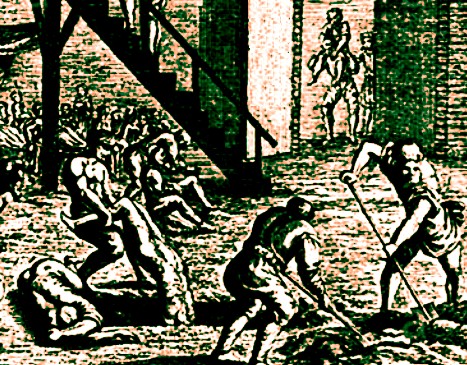
Artist: Christian Friedrich Fritzsch
Burial of the Dead in a Lazaretto, From Plague Hospital in Hamburg (1758)
so long as it didn't violate the rules about safety or interfere with the quarantine of others in the lazaretto.6 The 1695 instructions have a great deal to say about how a very ill patient should go about making a will if they so desired. The custodian was responsible for keeping a book titled 'Registro di Testamenti' (Testament Register) where all such wills were kept. Someone making a will was to do so with the custodian and chaplain as witnesses along with at least three other people. If the ill person couldn't write, the chaplain or guardian could make out the will and sign it in place of the sick.7
John Howard explains what was to happen when someone died in the Venice lazarettos. The lazaretto physician was to make a detailed report of what occurred and how the individual died. "There is a burial place within the lazaretto, and the dead are all buried naked, by those of their respective apartments, and if there is any suspicion of infection, a quantity of quick-lime is thrown upon the corpse in the grave, which is digged five or six feet deep."8 The 1716 Marseille instructions give a similar procedure: "When a patient suffering from the Plague dies on the Isle of Jarre [Île Jarre, south of Marseille where boats served quarantine], he will be buried there in quicklime, in order to have the carcass promptly consumed; and his clothes will be burned so that there remains no vestige"9. The 1661 Serenissima Republic instructions for Corsica, Caprara Island and Genoa state that when a ship arrives on which people died during the voyage, that if that ship arrived with a clean certificate of health, then, subject to a physician's or surgeon's examination of the corpse, who provides a sworn written report of there being no indications of the death being caused by plague, the ship will be given pratique and the corpse will may be interred.10
At the Malta lazaretto, medical historian Charles Savona-Ventura notes that doctors were similarly responsible for post-mortem examinations.11 Howard discusses a burial ground at the Manoel Island lazaretto in Malta, "where there seemed to have been some recent burials; and also a place for burning the bodies of such as die of the plague."12 Those who were in quarantine with the deceased then had to restart their quarantine if the death was in any way indicative of the plague.
1 John Howard, An Account of the Principal Lazarettos In Europe, 1791, p. 14; 2 Instruzzioni e gouerno del lazzaretto di Messina per la scala franca, 1695, p. 28 - translated by the author; 3,4,5 Daniel Panzac, "Appendix 1: INSTRUCTION POUR LES INTENDANTS DE LA SANTE SUR LES USAGES & COUTUMES DU BUREAU", Quarantines et Lazarets, 1986, p. 137 - translated by the author; 6,7 Instruzzioni e gouerno del lazzaretto di Messina..., p. 29; 8 Howard, p. 14-5; 9 Panzac, "Appendix 1", p. 137; 10 Simona Olivieri, "Istruzione ed ordini per la Sanità da osservarsi in tutti quei luoghi che hanno giurisdizione al mare, nell'una e l'altra Riviera della Serenissima Repubblica, compreso il Regno di Corsica, ed isola di Caprara", La Berio, Jan-Jul, 1999, p. 25; 11 Charles Savona-Ventura, Knight Hospitaller Medicine in Malta [1530-1789], 2015, p. 48; 12 Howard, p. 8

